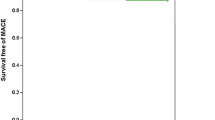Abstract
The number of very elderly patients with acute coronary syndrome (ACS) is increasing. Therefore, owing to the need for evidence-based treatment decisions in this population, this study aimed to examine the clinical outcomes during 1 year after percutaneous coronary intervention (PCI) in very elderly patients with ACS. This prospective multicenter observational study comprised 1337 patients with ACS treated with PCI, classified into the following four groups according to age: under 60, <60 years; sexagenarian, ≥60 and <69 years; septuagenarian, ≥70 and <80 years; and very elderly, ≥80 years. The primary endpoint was a composite of the first occurrence of all-cause death, nonfatal myocardial infarction, nonfatal stroke, and bleeding within 1 year after PCI. We used the sexagenarian group as a reference and compared outcomes with those of the other groups. The incidence of the primary endpoint was significantly higher in the very elderly group than in the sexagenarian group (36 [12.7%] vs. 24 [6.9%], respectively; hazard ratio, 1.94; 95% confidence interval: 1.16–3.26; p = 0.012). The higher incidence of the primary endpoint was primarily driven by a higher incidence of all-cause death. When the multivariable analysis was used to adjust for patient characteristics and comorbidities, no difference was observed in the primary endpoint between the very elderly and sexagenarian groups (p = 0.96). The incidence of adverse events after PCI, particularly all-cause death, in very elderly patients with ACS was high. However, if several confounders are adjusted, comparable outcomes may be expected within 1 year after PCI among this population.
Graphical abstract



Similar content being viewed by others
Data availability
Data supporting the findings of this study are available through the corresponding author upon request. The data are not publicly available because of privacy and ethical restrictions.
References
Tsugane S. Why has Japan become the world’s most long-lived country: insights from a food and nutrition perspective. Eur J Clin Nutr. 2021;75:921–8.
McNulty EJ, Ng W, Spertus JA, Zaroff JG, Yeh RW, Ren XM, et al. Surgical candidacy and selection biases in nonemergent left main stenting: implications for observational studies. JACC Cardiovasc Interv. 2011;4:1020–7.
Nallamothu BK, Normand SL, Wang Y, Hofer TP, Brush JE, Messenger JC, et al. Relation between door-to-balloon times and mortality after primary percutaneous coronary intervention over time: a retrospective study. Lancet. 2015;385:1114–22.
Barywani SB, Li S, Lindh M, Ekelund J, Petzold M, Albertsson P, et al. Acute coronary syndrome in octogenarians: association between percutaneous coronary intervention and long-term mortality. Clin Interv Aging. 2015;10:1547–53.
Sawano M, Kohsaka S, Ishii H, Numasawa Y, Yamaji K, Inohara T, et al. One-year outcome after percutaneous coronary intervention for acute coronary syndrome—an analysis of 20,042 patients from a Japanese nationwide registry. Circ J. 2021;85:1756–67.
Numasawa Y, Inohara T, Ishii H, Yamaji K, Kohsaka S, Sawano M, et al. Comparison of outcomes after percutaneous coronary intervention in elderly patients, including 10,628 nonagenarians: insights from a Japanese nationwide registry (J-PCI registry). J Am Heart Assoc. 2019;8: e011183.
Kimura K, Kimura T, Ishihara M, Nakagawa Y, Nakao K, Miyauchi K, et al. JCS 2018 guideline on diagnosis and treatment of acute coronary syndrome. Circ J. 2019;83:1085–196.
Natsuaki M, Morimoto T, Yamaji K, Watanabe H, Yoshikawa Y, Shiomi H, et al. Prediction of thrombotic and bleeding events after percutaneous coronary intervention: CREDO-Kyoto thrombotic and bleeding risk scores. J Am Heart Assoc. 2018;7:e008708.
Neumann FJ, Sousa-Uva M, Ahlsson A, Alfonso F, Banning AP, Benedetto U, et al. 2018 ESC/EACTS guidelines on myocardial revascularization. Eur Heart J. 2019;40:87–165.
Lawton JS, Tamis-Holland JE, Bangalore S, Bates ER, Beckie TM, Bischoff JM, et al. 2021 ACC/AHA/SCAI guideline for coronary artery revascularization: a report of the American College of Cardiology/American Heart Association Joint Committee on Clinical Practice Guidelines. Circulation. 2022;145:e18–114.
Manfrini O, Dorobantu M, Vasiljevic Z, Kedev S, Knežević B, Miličić D, et al. Acute coronary syndrome in octogenarian patients: results from the international registry of acute coronary syndromes in transitional countries (ISACS-TC) registry. Eur Heart J. 2014;16(Suppl A):A87–94.
Howe MJ, Seth M, Riba A, Hanzel G, Zainea M, Gurm HS. Underutilization of radial access in patients undergoing percutaneous coronary intervention for ST-segment-elevation myocardial infarction: insights from the Blue Cross Blue Shield of Michigan Cardiovascular Consortium. Circ Cardiovasc Interv. 2015;8: e002036.
Waldo SW, Secemsky EA, O’Brien C, Kennedy KF, Pomerantsev E, Sundt TM, et al. Surgical ineligibility and mortality among patients with unprotected left main or multivessel coronary artery disease undergoing percutaneous coronary intervention. Circulation. 2014;130:2295–301.
Acknowledgements
We thank the TWINCRE participants, investigators, and administrative staff of the TWINCRE study for their contributions.
Funding
No additional financial support was provided for the current study.
Author information
Authors and Affiliations
Contributions
HA, HO, KJ, and JY conceptualized and designed the original study. RS, MF, HT, TS, YI, YT, KY, AT, and SH collected the data and enrolled and followed up the patients. TK, HO, and HA analyzed and interpreted the data. TK, HO, and HA drafted the manuscript. HO and JY reviewed the manuscript.
Corresponding author
Ethics declarations
Conflict of interest
H. Otsuki and H. Arashi are affiliated with the Clinical Research Division for Cardiovascular Catheter Intervention and is financially supported by donations from Abbott, Boston Scientific, Medtronic, and Terumo.
Additional information
Publisher's Note
Springer Nature remains neutral with regard to jurisdictional claims in published maps and institutional affiliations.
Supplementary Information
Below is the link to the electronic supplementary material.
Rights and permissions
Springer Nature or its licensor (e.g. a society or other partner) holds exclusive rights to this article under a publishing agreement with the author(s) or other rightsholder(s); author self-archiving of the accepted manuscript version of this article is solely governed by the terms of such publishing agreement and applicable law.
About this article
Cite this article
Kawamoto, T., Otsuki, H., Arashi, H. et al. Adverse clinical events after percutaneous coronary intervention in very elderly patients with acute coronary syndrome. Cardiovasc Interv and Ther (2024). https://doi.org/10.1007/s12928-024-01020-6
Received:
Accepted:
Published:
DOI: https://doi.org/10.1007/s12928-024-01020-6




